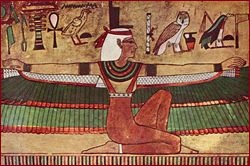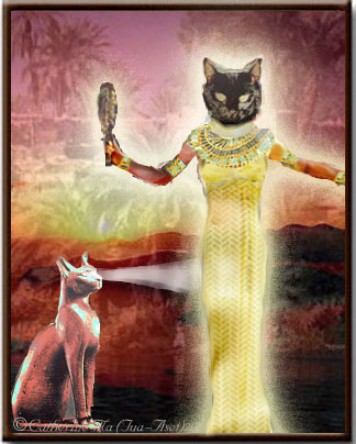"There is much to
learn from this god," says Rev. Tamara Suida, "even if none
of it is comfortable. Not all healing is without pain, and not all of
Set's lessons come without discomfort" (Daily Ma'at, 2/6/06).
 Aset
is probably one of the most well-known goddesses of ancient Egypt. Her
continued worship rose in popularity during Greco-Roman times where
She was known as Isis. The last pharaoh of Egypt, the renowned Cleopatra,
proclaimed herself to be "The Living Isis." Nowadays Aset
is still considered to be the consummate Mother-Goddess. In Her we seek
love and fidelity, strength and magic, compassion and healing.
Aset
is probably one of the most well-known goddesses of ancient Egypt. Her
continued worship rose in popularity during Greco-Roman times where
She was known as Isis. The last pharaoh of Egypt, the renowned Cleopatra,
proclaimed herself to be "The Living Isis." Nowadays Aset
is still considered to be the consummate Mother-Goddess. In Her we seek
love and fidelity, strength and magic, compassion and healing.
Aset is the sister/wife
of Wesir and played a primary role in resurrecting Him from the dead after
He was slain by His brother Set. Aset is usually portrayed in two forms:
one as a beautiful woman wearing a throne headdress, and as a winged woman.
She is also shown wearing the solar disk and horns indicating a later
synchronization with Het-hert (Gr. Hathor). She is sometimes depicted
as a kite (kestral or sparrow hawk), or as a kite with a woman's head.
This depiction—and Her wings—are thought to have come from the
story of how She turned herself into a bird in order to better search
for the body of Her slain husband.
In the New Kingdom influenced by the Greeks, Aset became the Patroness
of Sailors, and a big festival called The Isis
Navigatum was held every year during the summer in honor of this aspect.
Many Pagans and Kemetics continue to celebrate it nowadays as well. Aset
also was known as "Isis of a Thousand Names" in Rome. Among
Her many titles are Great of Magic (for her efforts in bringing back Wesir),
Mistress of the House of Life, Lady of the Green Crops, The One Who is
All, Queen of Heaven, Star of the Sea and Mother of God. Some of Her titles
were transferred to the Virgin Mary whose veneration is thought to have
evolved from Aset's worship as carried over into Coptic Christianity.
... the Coptic Christianity that was
consolidated in the fourth and fifth centuries offers a rich deposit
of "pagan survivals," proving either the error of the postapostolic
church (to some Protestant eyes) or the authenticating legacy of the
pharaohs in the contemporary Coptic church. (David Frankfurter, Religion
in Roman Egypt: Assimilation and Resistance, p.5)
The Madonna and Child iconography
throughout Christianity is also believed to have been influenced by numerous
Kemetic portrayals of Aset holding the Infant Heru (Gr. Horus) on Her
lap.
Set is portrayed as a red, dog-like creature with long, squared ears and an upright tail (thought to be a combination of the hyena and Cape Hunting Dog), or as a human with His animal-headed feature. He has dominion over the desert, called deshret (the Red Land) by the ancient Egyptians. Set has often been called "The Egyptian Satan" by other religions (the Temple of Set is not a Kemetic religion, but a 1970s offshoot of the Church of Satan), but this is not a very accurate or fair comparison. While He is called Lord of Storms and has a chaotic aspect to His nature, Set is not Evil Incarnate; on the contrary. He is the Defender of Ra who protects Him against the snake-like monster of un-creation, Apep (Gr. Apophis). A Late Kingdom text quotes Set Himself as "slaying the opponent of Ra daily while I am at the prow of the Boat of Millions, whereas not any [other] god is able to do it." Set does what is necessary, even if it seems harsh to us. He is the Chaos element that is often needed for change.


 Aset
is probably one of the most well-known goddesses of ancient Egypt. Her
continued worship rose in popularity during Greco-Roman times where
She was known as Isis. The last pharaoh of Egypt, the renowned Cleopatra,
proclaimed herself to be "The Living Isis." Nowadays Aset
is still considered to be the consummate Mother-Goddess. In Her we seek
love and fidelity, strength and magic, compassion and healing.
Aset
is probably one of the most well-known goddesses of ancient Egypt. Her
continued worship rose in popularity during Greco-Roman times where
She was known as Isis. The last pharaoh of Egypt, the renowned Cleopatra,
proclaimed herself to be "The Living Isis." Nowadays Aset
is still considered to be the consummate Mother-Goddess. In Her we seek
love and fidelity, strength and magic, compassion and healing.